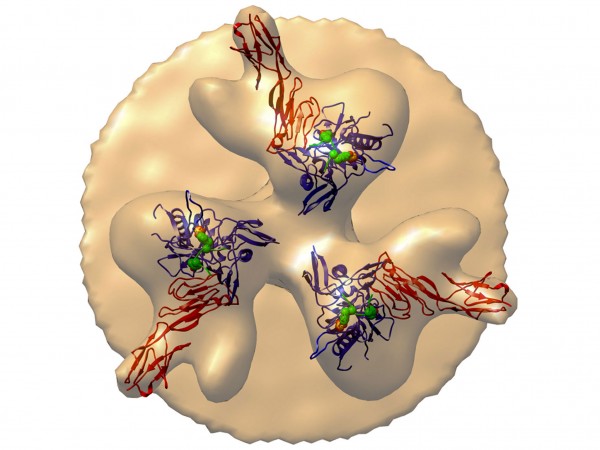پروتئین مصنوعی میمونها را از اچ آی وی محافظت میکند
مولکول پروتئین آزمایشگاهی ایجاد شده, روزی عفونت اچ آی وی و تکثیر آنرا متوقف خواهد ساخت.
آزمون اولیه این آزمایش در نوعی از میمونهای اولیه بنام ماکاکه نشان داد که این راه موفقیت آمیزتر از تمامی واکسن های شناخته شده است.
بیش از 30 سالست که محققان ویروسی را کشف کرده اند که تاکنون از عواقب ناشی از آن تا به این روز, موجب مرگ میلیون ها نفر از مردم جهان شده است. علت آن ویروس “اچ آی وی” است که موجب نقض سیستم ایمنی بدن انسان “ایدز” می باشد. از آن زمان جستجو بدنبال یک حفاظت کننده موثری برای پیشگیری از این ویروس عفونی ادامه دارد.

An aerial view of HIV’s surface proteins (blobs) shows how eCD4-Ig can bind to the virus and “neutralize” it. (adapted from Michael Farzan et al., Nature, 2015)
در حال حاضر دانشمندان یک روش جدیدی ارائه کرده اند: یک تیم با مطالعات سلولی و حیوانات مورد آزمایش قرار گرفته موفق می شوند, از طریق یک مولکول پروتئینی که به طور خاص از دو سمت به روی ویروس بسته شده و در نتیجه موجب توقف و جلوگیری از عفونت ویروس اچ آی وی شود.
بنابر اظهارات تیم آزمون “مجله طبیعت” مینویسد, این پروتئین به مانند چند مدل از پاتوژن های ایدز به مانند دو نوع گروه اچ آی وی 1 و 2 را نیز خنثی کرده و همچنین میمونهای مورد آزمایش را ماهها از عفونت ویروس اچ آی وی محافظت می کند.
دانشمندان همچنین معتقدند که یک استراتژی با معنا و عاقلانه اینست که بدنبال ایجاد یک واکسن کلاسیک نباشیم, بلکه روی جزئیات “آنتی بادیها” و یا روی همین مولکولها به مانند ایجاد “پروتئین مصنوعی” و تولید آن متمرکز شویم.
آقای فرانک کیرشهف ویروس شناس و یکی ازمحققین ویروس اچ آی وی در کلینک دانشگاه اولم آلمان می گوید, برای اینکه بدانیم این روش تا چه اندازه مطمئن است, می بایست هنوز بیشتر بر روی آن بررسی کنیم.
برگردان از مجله اینتریتی آلمانی “زمان” و “مجله علوم” انگلیسی زبان استرالیایی
برگردان: کیومرث سراج الهی مشاور سیستم بهداشت, پیشگیری و درمان بیماریهای آمیزشی و اعتیاد در آلمان

